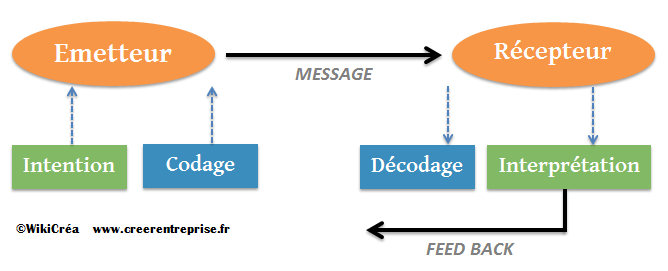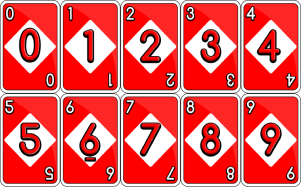
This is a theory which was told to me orally, and I find it demonstrates the differences between autistic and non autistic communication really well. It’s not a theory in the scientific sense of the term, but it could be an accessible illustration to help to explain these differences.
UNO is a fairly simple card game. Each card has a number from 0-9 and a colour: green, blue, yellow and red, and there are also wild cards. When a player puts a card in the central pile the next player must match either the colour or the number of that card with a card of their own. So, for example, if the card in the pile is red with the number ‘1’, the next player must play either another red card, or another card of a different colour with a number ‘1’ (or a wild card). The aim is to get rid of all your cards.

In most interpersonal communication (oral or written), whether intentionally or not, there are two main aspects: the factual aspect and the emotional aspect. Our illustrative UNO card can therefore represent the factual element as the number (eg. ‘1’), and the emotional element represented by the colour (eg. Red).
When we communicate, we have one or more objectives (such as giving information, seeking help, fulfilling a physical need etc.). However, we are not always successful in achieving them! So, does this mean we are communicating badly? That’s possible, but then again it might not be the real issue.
Sometimes, without anyone being at fault, the problem can be the communication “gap” in understanding between the person expressing the message and the person receiving it.
A basic communication flow chart would show:
emitter —>
-> encoding
-> message
-> decoding
-> receiver
-> feedback
-> sender

The sender has an intention, they send a message to the receiver who interprets it; they then feedback this interpretation to the sender.
Let’s say my message is represented by the Red ‘1’ card. What is my intention? There are two possibilities with UNO theory – the emotional (Red side) aspect, and the factual (number ‘1’ side) aspect. If I’m looking at the factual side, I may be unaware of the emotional side, and vice versa. In the same way, the message receiver will prioritise either Red or ‘1’, depending on their own filters.
If my message intention is ‘1’, and the receiver has interpreted Red, the feedback I receive from them will be very different to what I was expecting. Remember that in the game, a Red ‘1’ card can be followed by another Red ‘1’ card, but also a Blue ‘1’, a Green ‘1’ or a Yellow ‘1’.

Let’s imagine that the receiver responds to my message with a yellow ‘1’ card. Success – my intent was the factual aspect, the receiver understood this and responded in kind. The feedback I receive will match my expectations.
However, if the receiver focuses on the emotional Red aspect, they will respond by giving me a Red card with a different number and this is not what I was expecting at all. If there is more than one receiver (for example in a group discussion, or on social media), I may get a lot of unexpected feedback which I will fail to understand.

Conversely, if I am the receiver, I might focus on the aspect which is not that intended by the sender. If their emotional message consists of a Red ‘1’ card and they’re expecting any other emotional Red card in return (empathy, anger, disappointment, joy etc.), but I respond with a factual ‘1’, my feedback will not meet their expectations.
Technically, according to the rules of the game, these are not incorrect responses. But my personal filters did not allow me to decode the sender’s intent, resulting in incomprehension.
Frequently, autistic people don’t focus on the emotional aspect of communication, and expect precise, factual responses. Similarly, unlike the majority of population, their own responses will instinctively be factual ‘1’ style rather than emotional Red style. This can be disastrous because they come across as being cold, insensitive, even standoffish, and in any case inappropriate. Even if the responses are technically correct, the responses do not meet the expectations of the message senders.
Other autistic people may find emotions hard to identify and process, and for them the factual element will be dampened with their emotional Red might be brighter than expected, or may evolve into different colours; once again, their response will seem unsuitable.

This kind of misunderstanding, based on EITHER ‘1’ OR Red, can happen to anyone, depending on their state of mind, or their emotional state. But an autistic person may need rather longer to realise their error and correct it – if indeed they are able to do so. Furthermore, the autistic person may not even realise what it is they have done wrong in the communicative exchange. After all, didn’t they technically obey the rules? So, what’s the problem? Why does the other person seem upset or angry?
A neurotypical person, used to the Red emotional angle being prioritised (and it’s noticeable if we take a little time to observe these patterns), will fail to understand the factual ‘1’ intention of the autistic person – such as pointing out facts or offering a solution – and will instead notice the absence of the Red emotional side. This has the effect of heightening their emotions, because they feel misunderstood. And if neither party is able to step back, the communication, and the relationship, can break down very
quickly.
This kind of misinterpretation can happen to anyone, at any time, even without autism in the mix. In any case, UNO theory can help us to take a step back and try to resolve some of the misunderstandings. The question to ask in case of a communication breakdown, even a subtle one:
Which aspect (emotional or factual) was my interlocutor focused on?
The best way to find out is often to ask them! 😉
Thanks to Suzanne Comberousse/Clear Autism for translating this article into English. You can find her site here.
The Theory on Twitter:
Attention : les créations présentes sur ce site sont soumises au droit d’auteur. L’utilisation pour votre usage personnel est autorisé, mais aucune modification sans autorisation préalable de l’auteure n’est permise. Pour toute autre utilisation que personnelle, me contacter. Merci, en règle générale, de respecter le travail d’autrui.
Envie de soutenir ce blog ? Paye moi un thé sur ko-fi.





1 réflexion au sujet de “Autistic Communication: the factual aspect, the emotional aspect and the UNO Theory”